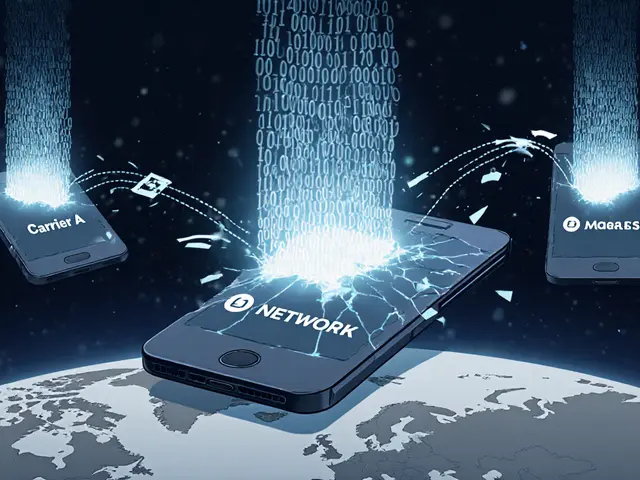Stolen Phone Blacklist Validator
How This Simulates Lox Network
This tool demonstrates the concept described in the article: checking a phone's IMEI against a blockchain-based blacklist. While the real Lox Network claims to create a global system, this simulation shows how it would function if adopted.
Note: The Lox Network (LOX) token project mentioned in the article has no verified implementation. This is a conceptual demonstration only.
Lox Network (LOX) isn’t another meme coin or DeFi experiment. It’s a crypto project built around one very specific, very real problem: smartphone theft. The idea sounds simple - use blockchain to create a global blacklist of stolen phones. But behind that idea is a token, a dual-NFT system, and claims that have yet to prove themselves in the real world.
What Lox Network actually does
Lox Network wants to turn your phone’s IMEI number - that 15-digit serial code built into every mobile device - into a digital ownership record. When a phone is stolen, the owner can report it. That IMEI gets added to a blockchain-based blacklist. If someone tries to activate that phone on a carrier network, the system flags it. The goal? Make stolen phones useless and kill the resale market.
That’s not science fiction. Carriers and law enforcement already use IMEI blacklists. But those lists are fragmented. One carrier’s blacklist doesn’t talk to another’s. Lox Network says it fixes that by creating a single, global, decentralized database anyone can check. That’s the pitch.
They call it the world’s first blockchain mobile security network. And they back it with two types of NFTs: SmartNFT for digital proof of ownership, and SmartLOX NFT tied directly to the physical device’s IMEI. The LOX token powers everything - paying for reporting, rewarding users who help track stolen devices, and funding the network’s DAO-governed operations.
How LOX token works (and why it’s barely moving)
The LOX token is the lifeblood of the ecosystem. You need it to interact with the network: submit a theft report, verify ownership, or even just check if a used phone is clean. It runs on the XRP Ledger, which keeps transaction fees low and speeds fast - a smart move for a system meant to work globally.
But here’s the problem: almost no one is using it.
As of November 2025, LOX trades at around $0.00005. That’s down 99.7% from its all-time high of $0.016 in 2023. The 24-hour trading volume hovers around $100. For context, Bitcoin trades over $20 billion in the same time. LOX isn’t just small - it’s invisible in crypto markets.
It’s listed only on BC.Game, a gambling platform, and a few tiny exchanges. Not on Binance. Not on Coinbase. Not even on KuCoin. That tells you everything. If a major exchange won’t list it, the market doesn’t trust it. And if no one’s trading it, the network can’t grow.

Who’s supposed to use Lox Network?
Lox Network claims partnerships with law enforcement, phone carriers, manufacturers, and insurers. But you won’t find any names. No press releases. No case studies. No public logs showing a stolen iPhone being blocked because of LOX.
Imagine this: you buy a used phone. You check its IMEI on Lox Network’s website. It comes back clean. Great. But how do you know the system actually works? What if the seller just didn’t report the theft? Or the carrier didn’t integrate? Without real-world proof, it’s just a website with a token.
Developers are supposed to build on it too. But there’s no public API. No developer docs. No GitHub repo. No tutorials. How are you supposed to build something on a platform you can’t even access?
Why this project feels broken
Lox Network’s biggest flaw isn’t the tech. It’s the disconnect between ambition and reality.
They claim to be revolutionizing mobile security. But the global smartphone theft market? Worth billions. The solutions that actually work - like Apple’s Activation Lock or Google’s Factory Reset Protection - are built into the operating systems themselves. Those are hard to bypass. Lox Network is trying to solve the same problem with a token and a blacklist that no one’s using.
And then there’s the data. LiveCoinWatch shows its market cap as $0.0. CoinMarketCap lists a trading volume of $104.84. That’s not a startup. That’s a ghost. No Reddit threads. No Twitter buzz. No news coverage from CoinDesk, Messari, or even crypto blogs. Zero community. Zero traction.
Even the price charts look like a glitch. Bollinger Bands are squeezed so tight, the price barely moves. The simple moving average sits at $0.0000599. The current price? $0.000057. It’s not volatile - it’s dead.

Is Lox Network a scam?
Not necessarily. There’s no evidence of a rug pull. The website still exists. The token still trades. The team hasn’t vanished.
But that’s not enough. A project doesn’t need to be a scam to be dead. It just needs to fail to gain adoption. And LOX has failed. Spectacularly.
It’s like building a new traffic light system and then only installing one light in a town of 10 million people. You can explain the theory all day - better coordination, fewer accidents, smarter flow. But if no one uses it, it doesn’t matter.
Lox Network’s vision is solid. But execution? Nonexistent. Without partnerships that actually go live, without exchange listings, without user adoption, it’s just a whitepaper with a token ticker.
What’s the bottom line?
If you’re asking, "Should I buy LOX?" - the answer is no. Not because it’s fraudulent, but because it’s irrelevant.
There’s no upside. No liquidity. No community. No development activity. No real-world use. The price isn’t going to spike. There’s no catalyst. No one’s waiting in the wings to invest. The market has already voted - and it walked away.
Lox Network isn’t a crypto coin you invest in. It’s a case study in how even a good idea can die if no one believes in it enough to make it real.
Want to fight smartphone theft? Use built-in security features. Report stolen devices to your carrier. Buy from trusted sellers. That’s how you protect your phone - not by buying a token that trades for less than a penny.
LOX might still exist on paper. But in the real world? It’s already gone.

Write a comment